Lachish Conveniences
One of the most fascinating sites in Israel is Tel ed-Duweir, better known as Biblical Lachish. Curiously, it is the finds made elsewhere, rather than what has been uncovered during excavations on site, that have made the city famous.
Prior to the age of archaeology Lachish was known only from the Bible. It was one of the chief cities that resisted the Israelite conquest of Palestine and even when its king was captured and hung (or possibly impaled) by Joshua, the city withstood a two day siege (Joshua 10:32) before being over-run and the population massacred.
The city features briefly in the conspiaracy against Amaziah, who escaped from Jerusalem and fled to Lachish, an important royal city, but the conspirators caught up with him there and killed him. The next mention is during the reign of Hezekiah, when the Assyrians laid siege to the city. The Bible baldly states that Hezekiah sent a message to the Assyrian king, Sennacherib, saying, "I have offended," but as Hezekiah was one of the "good" kings of Judah, the idea that he might have done anything wrong didn't sit comfortably with most Bible expositors.
The usual suggestion was that it may have been a tactical admission to ward off the attack on Jerusalem itself which soon followed but was triumphantly defeated by Divine intervention. As the King James Version puts it, "And it came to pass that night, that the angel of the Lord went out, and smote in the camp of the Assyrians an hundred fourscore and five thousand: and when they arose early in the morning, behold, they were all dead corpses." It must indeed have been somewhat of a shock to wake up and find yourself dead!
Lachish is mentioned by the prophet Micah, who condemns the city as "the beginning of sin to the daughter of Zion" and castigates it because "the transgressions of Israel were found in you". Presumably this is a reference to the golden calves set up by Jeroboam and worshipped throughout its history by the northern kingdom.
The final reference to the place is in Jeremiah, who makes an off-hand reference to the Babylonians laying siege to the city which, together with Jerusalem and Azekah, were all that was left of the kingdom of Judah.
Thus the Biblical picture is of a city that was merely one of many in Judah and not particularly distinguished in any way. That began to change when Henry Layard excavated Nineveh and brought home two objects whose significance could not be understood until the cuneiform script was deciphered some twenty years later.
The first was a stunning series of reliefs depicting the siege and capture of a strongly fortified city. Clearly the Assyrians considered it one of their most significant accomplishments, for them to devote a whole room in the royal palace to the subject. The reliefs show the Assyrian army in action, with platoons of slingers, the royal throne set up so that the king can oversee operations, and giant war machines armed with pointed bars being moved up to the city walls to batter their way in. Meanwhile scaling ladders are set up, men protected by their shields pry away at the foundations of the walls, and finally, despite storms of arrows from the defenders, the attackers swarm over the city walls.
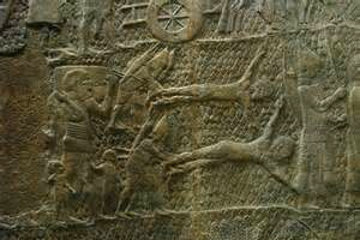
| |
| Prisoners from Lachish being flayed alive below the city walls. |
Next we see long lines of prisoners being led away into life-long captivity. They were the lucky ones, because the reliefs also show the fate of those selected for "special measures" - two men pegged out on the ground while they are flayed alive, and others impaled on sharp-pointed stakes forced up under their rib cages.
The discovery that this city was Biblical Lachish set British society agog and the Lachish Reliefs became - and remain - one of the most popular exhibits in the British Museum. The casual brutality depicted in the reliefs was intensified by the inscription over the throne, which reads: "Sennacherib, the mighty king, king of the country of Assyria, sitting on the throne of judgment, before the city of Lakhisha. I give permission for its slaughter"
The second object discovered by Layard was somewhat more curious, even though it does not specifically mention Lachish. Layard brought a number of the Assyrian human-headed bulls back to London. In an era without modern machinery, that was quite an achievement! Each bull had to be lowered on its side onto a huge wooden cart, which was then dragged to the nearby Tigris river and loaded onto a raft made of inflated goat skins. The raft and its cargo was then floated down to Basra, after which the Royal Navy took over and transported the huge bulls to Britain.
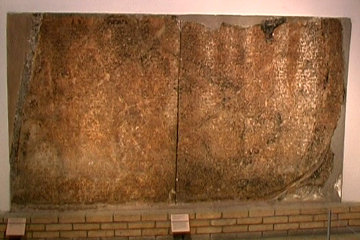
| |
| The "bird in cage" inscription in the British Museum. You can clearly see where the bull's legs have been chiselled away. |
There was one bull, however, which was simply too big for Layard to manage. Between its legs, however, there was a lengthy inscription - remember, this was in the days when opinion was still divided over whether the strange, wedge-shaped marks were writing or merely a form of decoration. For some reason Layard was impressed that the inscription was important, so he chiselled away the rest of the bull and brought the inscription back to London!
Twenty years later his hunch was confirmed when the inscription could be read. It turned out to be by the Assyrian king Sennacherib, boasting of his conquests in Palestine. There is a long list of the cities he conquered and destroyed, but rather lamely he says, "and I shut Hezekiah up in Jerusalem like a bird in a cage"! As the Assyrian war machine, when it really got going, was pretty well unstoppable, this failure to destroy Jerusalem and carry off its king was seen as comfirmation of the Biblical account of Divine intervention.
Two further things supported the historicity of the Biblical account. The first was the discovery that Hezekiah was not just a "good" king with the worship of Yahweh at heart, but he was also the organiser of a significant rebellion against Assyrian overlordship. At the very time when the angel of the Lord was smiting the Assyrians, Hezekiah had Padi, king of Ekron, in a dungeon in Jerusalem for refusing to join the rebellion! No wonder Hezekiah wrote and admitted, "I have offended".
The second was an Assyrian tablet which admitted that Sennacherib was assassinated by two of his sons while worshipping in a temple in Nineveh. The only difference was that the Bible says that he was "killed with the sword" (an expression which can be merely a generic statement that the death was by violence) whereas the Assyrian record states that the assassins battered their father to death with a statue of the god.
While all these discoveries were triumphant confirmations of Biblical accuracy, they did leave a theological problem: it was all very well Hezekiah and Jerusalem being delivered from Assyrian wrath, but what about the unfortunate inhabitants of Lachish and other places? Did God not care for them? Were no angels sent out to deliver them from death or worse?
Eventually, in 1932, work began on Tel ed-Duweir, under the unfortunate British archaeologist James Starkey who was murdered by Arabs (see an article elsewhere on this site about his death). The excavations confirmed that Tel ed-Duweir, not Tel el-Hesi, was Lachish and early in the work the archaeologists uncovered a gate whose size and position matched the gate depicted in the Lachish Reliefs. When, in addition, significant quantities of Assyrian arrow heads, sling stones, and even a helmet and bronze armour were found, it was clear that this was the city that had been captured by Sennacherib (and, later, by the Babylonians).
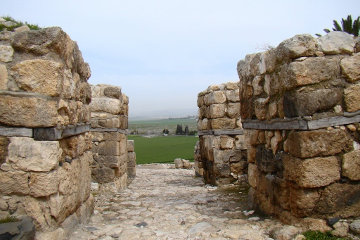
| |
| The six-chambered gateway at Megiddo, built, like the temple, with three courses of stone and one of wood. |
The gate was interesting, because it consisted of a passageway flanked by three chambers on each side. It was the Israeli archaeologist Yigael Yadin who first recognised the significance of this construction when he noted that the gate he excavated at Hazor was a six-chamber gate. The Bible says that Solomon built three "chariot cities" - Hazor, Megiddo and Gezer. Yadin remembered that the excavators at Megiddo had also found a six-chamber gate and when he looked it up, he discovered that not only was the pattern identical, but even the measurements were almost the same. That prompted him to search in the records for the excavation of Gezer, where he found a "Maccabean castle" that was built to the same pattern and size and, quite obviously, had nothing to do with teh Maccabees! His conclusion was that the gateways provided proof that Solomon had indeed built all three cities, using a standard pattern for the gates.
When I read that I was intrigued, because I was familiar with the description of Ezekiel's visionary temple, whose gateways also had six chambers (for example, Ezekiel 40:21). I checked the measurements and found that they closely matched those of Solomon's gates and gained my Master's Degree with a thesis in which I demonstrated that Ezekiel's temple was merely the temple of Solomon rebuilt.
Since then the discovery of six-chamber gates has multiplied and it is no longer certain that the design was peculiar to Solomon (though the similarity in measurements between Hazor, Megiddo, Gezer and Ezekiel does indicate a common architectural heritage). I do not know who built the six-chamber gate at Lachish, though it is not impossible that it may have been constructed by Solomon.
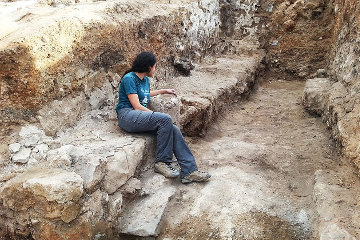
| |
| The seat in the gateway at Lachish, where city business was transacted. |
One peculiarity seen in the Lachish gate, but not, so far as I am aware, in the other gates, is the provision of seating in at least one of the chambers. The gateway appears to have been where city business was conducted. When Boaz wanted to transact the legal formalities that allowed him to have not only Ruth but her land as well, he did it in the gate (Ruth 4:1) and one of the marks of a successful female entrepreneur is that her husband has leisure to sit in the gate and get involved in local politics (Proverbs 31:23).
In recent years the Israeli Antiquities Authority has been working with various Israeli and American institutions to conduct further excavations at Lachish. They have identified the Assyrian siege ramp, as dramatic - though perhaps not as visible - as the well-known Roman siege ramp at Masada. They have also worked on the gate and the most recent discovery (2016) has perhaps answered the theological problem mentioned above.
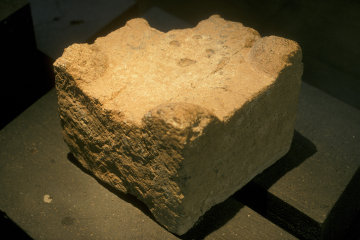
| |
| A horned altar found at Hazor. The altars at Lachish would have look like this. |
It appears that one of the six chambers of the gate housed a shrine. Although no image has been found, such a shrine was probably to a heathen god or, at the very best, to some syncretistic deity such as the "Yahweh-Baal" found at Tel Arad in the Negev. A pair of horned altars were found in the chamber, together with pottery fragments of lamps, bowls and incense stands. Such a shrine would be a convenience to travellers, who could offer up prayers for safety as they left the city to begin their journey; it would also ensure that the god had a vested interest in preserving the gateway against intruders and enemies.
The interesting thing was that on both altars, the four "horns" had been broken off. One or even two might be damaged in the vicissitudes of war and destruction, but not all eight! This pointed to intentional desecration of the little shrine - and the probable perpetrator was not far to seek. 2 Kings 18:4 states that at the beginning of his reign, Hezekiah declared war on heathen religion in his kingdom.
"He did what was right in the eyes of the Lord, just as his father David had done. He removed the high places, smashed the sacred stones and cut down the Asherah poles. He broke into pieces the bronze snake Moses had made, for up to that time the Israelites had been burning incense to it. (It was called Nehushtan.)"
It was the next discovery which really excited the excavators. The two altars stood in an inner room which probably represented the holy of holies for the little shrine, and right next to them was a stone block that had a hole cut through its middle. The size and shape of the block and the shape of the hole were unmistakable: this was a toilet seat!
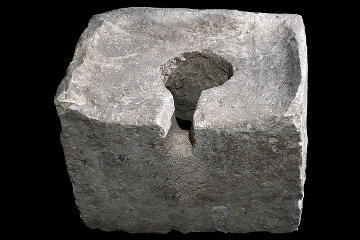
| |
| The stone toilet seat found in the gateway at Lachish. |
The Bible records how King Jehu of the northern kingdom attempted to purge his state of idolatry.
"They brought the sacred stone out of the temple of Baal and burned it. They demolished the sacred stone of Baal and tore down the temple of Baal, and people have used it for a latrine to this day."
2 Kings 10:26, 27
It would seem that Hezekiah followed the example of his predecessor and turned the holy of holies into a public toilet, no doubt with the intention that the guards on the gate and people leaving or entering the city would use it and thus irretrievably pollute the shrine.
The problem is that you can install a toilet, but you cannot compel people to use it. The archaeological team conducted laboratory tests on the earth below and around the stone block and found no evidence that the toilet had ever been used. In fact, soon after the stone was put in place someone deliberately blocked off the doorway so that it remained hidden until the excavators uncovered it.
In other words, the people of Lachish might have had their shrine destroyed and defiled, but in their hearts they still remained loyal to whatever god was worshipped there. Yahweh, the God of Israel, was to them a resented foreign deity - no wonder that God allowed the Assyrians to capture and destroy the city. Many years previously God enunciated a fundamental principle of His relationship with humans: "Those who honour me I will honour, but those who despise me will be disdained." (1 Samuel 2:30) Those reliefs in the British Museum show the people of Lachish learning that very important lesson the hard way.
© Kendall K. Down 2016





